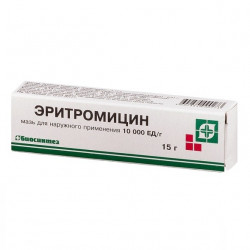



 All payments are encrypted via SSL
All payments are encrypted via SSL
 Full Refund if you haven't received your order
Full Refund if you haven't received your order
Enteric coated tablets: 1 pill contains 100, 250, or 500 mg of Erythromycin;
10, 20 pcs. packaged.
Ointment for external use: 1 g ointment contains erythromycin (in terms of the active substance) - 10,000 IU;
on 10, 15, 30 g in tubes.
Eye ointment: 1 g ointment contains erythromycin (in terms of the active substance) - 10,000 IU;
7, 10, 15 g in tubes.
Macrolide antibiotic. Acts bacteriostatic. Spectrum of experience;., Treponema pallidum, Legionella pneumophila).
Erythromycin resistant most gram-negative bacteria (Escherichia coli, Shigella, Salmonella spp.), mycobacteria, small and medium-sized viruses, fungi.
Erythromycin is better tolerated by patients than penicillins, and can be used for allergies to penicillins. The resistance of microorganisms to the drug develops rapidly.
Erythromycin is well absorbed from the gastrointestinal tract and penetrates into most body fluids.
With meningitis, the penetration of the drug through the blood-brain barrier increases. In patients with normal liver function, erythromycin is concentrated in its tissue and excreted in the bile. The effect of impaired liver function on the excretion of erythromycin is unknown.After taking Erythromycin orally, less than 5% of the accepted dose is excreted by the kidneys in unchanged form. Erythromycin crosses the placenta, but its concentration in the fetal plasma is insignificant.
Pills:
Infectious and inflammatory diseases caused by microorganisms susceptible to the drug, including:
- diphtheria;
- whooping cough;
- trachoma;
- brucellosis;
- Legionnaires disease;
- sore throat;
- scarlet fever;
- infections of ENT organs (tonsillitis, otitis media, sinusitis);
- infections of biliary tract (cholecystitis);
- infections of the upper and lower respiratory tract (tracheitis, bronchitis, pneumonia);
- infections of the skin and soft tissues;
- gonorrhea;
- syphilis;
Treatment of infectious and inflammatory diseases caused by pathogens (in particular Staphylococcus spp.) Resistant to penicillin, Tetracycline, chloramphenicol, streptomycin.
Ointment:
Infections of the skin and soft tissues (pustular skin diseases, including juvenile acne, infected wounds, pressure sores, burns of the II-III centuries, trophic ulcers).
Eye ointment:
Eye infections caused by susceptible microorganisms: conjunctivitis (including in newborns), neonatal ophthalmia, bacterial blepharitis, blepharoconjunctivitis, keratitis, meybomit (barley), chlamydia, trachoma.
Pills administered orally for 1-1.5 hours before meals or 2-3 hours after meals.
Single dose for adults 0.25 g, for severe diseases - 0.5 g. Accepted every 4-6 hours.
The highest single dose for adults - 0.5 g, daily - 4 g.
Children under 3 months prescribed in a dose of 20-40 mg / kg per day; aged 4 months to 18 years - 30-50 mg / kg per day. The multiplicity of appointments - 4 times. The course of treatment is 5-14 days; after the disappearance of the symptoms of the disease, the drug is prescribed for another 2 days.
The duration of treatment depends on the form and severity of the disease and is 5-14 days.
Ointment put on the affected skin 2-3 times a day, with burns - 2-3 times a week, the duration of treatment - 1.5-2 months.
Eye ointment: for eye diseases - 0.2-0.3 g of ointment is laid at the lower or upper eyelid 3 times a day, with trachoma - 4-5 times a day, the duration of treatment is up to 4 months.
Maybe: abnormal liver function, nausea, vomiting, epigastric pain, skin allergic reactions.
Seldom: cholestatic jaundice, anaphylactic shock.
Local reactions: hyperemia, burning, itching, irritation and flaking of the skin; irritation of the mucous membrane of the eye, blurred vision.
Hypersensitivity, jaundice (in history), hepatic and / or renal failure, concomitant use of terfenadine or astemizole.
Erythromycin can be prescribed for penicillin allergy.
The drug is prescribed with caution in violations of the liver and / or kidneys.
Erythromycin is not recommended to drink milk and dairy products.
Erythromycin crosses the placenta, is excreted in breast milk, therefore, when prescribing the drug during periods of pregnancy and lactation, the estimated benefits to the mother and the potential risk to the fetus should be assessed.
Erythromycin is incompatible with Lincomycin, Clindamycin and chloramphenicol due to antagonism of action.
When taken simultaneously with terfenadine or astemizole increases the risk of arrhythmias.
With the simultaneous use of Erythromycin with drugs that block tubular secretion, the half-life of erythromycin is prolonged.
Erythromycin reduces the bactericidal effect of beta-lactam antibiotics (penicillins, cephalosporins, carbapenems).
With simultaneous use of Erythromycin with theophylline increases the concentration of the latter.
With simultaneous use with drugs whose metabolism occurs in the liver (carbamazepine, valproic acid, hexobarbital, phenytoin, alfentanil, disopyramide, lovastatin, bromocriptine), the concentration of these drugs in the plasma may increase, because Erythromycin is an inhibitor of liver microsomal enzymes.
Erythromycin increases cyclosporine nephrotoxicity (especially in patients with concomitant renal failure).
Erythromycin reduces the clearance of triazolam and midazolam, and therefore may enhance the pharmacological effects of these benzodiazepines.
With simultaneous use of Erythromycin with dihydroergotamine or unhydrogenated ergot alkaloids, vasoconstriction with the development of spasms, dysesthesia is noted.
Erythromycin slows down the excretion and enhances the effects of methylprednisolone, felodipine, and coumarin anticoagulants.
With a joint appointment with lovastatin may develop rhabdomyolysis.
Erythromycin increases the bioavailability of Digoxin and reduces the effectiveness of hormonal contraception.
List B. In a dry place at room temperature. Keep out of the reach of children.
It is released on prescription.
Erythromycin